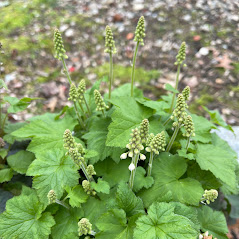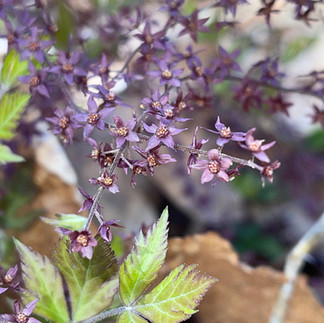Garden Obstacles: Alternatives to Invasive Ground Covers
- Kimberly Simmen
- Jan 3, 2024
- 7 min read
Updated: Aug 24, 2024
It's almost that time of year again to start working in the garden. Here is my rant about The Home Depot, Lowe's, and all the big box stores. Please stop buying your plants at these establishments as they all still carry non-native, awful ground covers like creeping Jenny, English ivy, pachysandra, and vinca. Even more absurd to me is how they are still selling Bishop's weed (goutweed). This plant is evil and should be on the 'Do Not Sell' list (Burrell, Marinelli, Harper-Lore, 2011). Some are carrying the so-called sterile cultivars. Please do not buy cultivars of these awful invasive plants. My last bit, if you go to a garden center and they have a native plant section you have to walk by the fertilizers, herbicides, and invasive plants to find them. Always question the motives of that garden center!
Now that I have that off my chest, let's talk about alternative native ground covers (Burell, Marinelli, Harper-Lore, 2011) to use instead of non-native, awful varieties.
Please do not use the following ground covers:
Bishop's Weed aka Goutweed (Aegopodium podagraria)
Bugleweed (Ajuga species and cultivars)
Chameleon Plant (Houttuynia cordata) - how is this not on either list for NYS?
Creeping Jenny (Lysimachia nummularia and cultivars)
Spotted Dead-nettle (Lamium maculatum and cultivars)
Yellow Archangel (Lamiastrum galeobdolon and cultivars)
Instead of planting the following evergreen invasive/aggressive non-native ground covers:
Creeping Euonymus (Euonymus fortunei) (NYSDEC, 2014)
English Ivy (Hedera helix)
Lily-turf (Liriope spicata, Liriope muscari and cultivars)
Pachysandra aka Japanese Spurge (Pachysandra terminalis and cultivars)
Periwinkle/Myrtle (Vinca minor, Vinca major, and cultivars)
Plant these native semi-evergreen and evergreen ground covers instead:
Carex albicans (white-tinged sedge): May 'bloom', 12-18" tall, semi-evergreen, sun to shade, average-moist soil, drought tolerant, deer resistant, North American native including Long Island.
Carex grayi (mace sedge): May through October 'bloom, attractive star-shaped seed heads persist through November, sun to partial shade, 24-30" tall with a spread of 24", semi-evergreen, moist to wet soil, tolerates some drought, great for a rain garden, deer and rabbit resistant, tolerant of Black Walnut trees (juglone), native to Eastern North America including Long Island.
Carex stricta (tussock sedge): June 'bloom', 12-36" tall, evergreen, sun to partial shade, medium-wet soil, deer resistant, good for erosion control due to its aggressive habit, great cut and dried 'flower', great in a planter, attracts birds and butterflies, Central US native including Long Island.
Chrysogonum virginianum 'Allen Bush' (goldenstar aka green & gold): bright, golden yellow flowers May through October, 3-6" tall plants and a 12" spread, semi-evergreen, partial shade to full shade, average but well-drained soil, tolerates clay soil, deer resistant, native to the Southeastern United States.
Chrysogonum virginianum var australe (goldenstar aka green & gold): bright, golden yellow flowers in May through June on 6" tall plants with a spread of 12", semi-evergreen, partial to full shade, average but rich, well-drained soil, deer resistant, native to the Southeastern United States.
Fragaria virginiana (wild strawberry): white flowers in May, sweet red berries in June, 4-6" tall, dry-average but well-drained soil, sun to partial shade, spreads by runners, host to Gray Hairstreak butterfly, native to Eastern North America including Long Island. Noteworthy cultivars: Fragaria virginiana 'Intensity' has larger berries and is considered an 'ever bearer' as it fruits June-September and Fragaria virginiana 'Port Huron' has larger leaves than the species.
Gaultheria procumbens (wintergreen): small, bell-shaped flowers in June through July followed by edible red fruit, 3-6" tall with a spread of 24-36", evergreen, partial shade to full shade, dry to moist but well-drained soil, slow spreading ground cover, Eastern North America including Long Island.
Geum fragarioides (barren strawberry): yellow flowers in April through May, 4-6" tall with a spread of 12", evergreen, bronzy red fall color, partial to full shade, average to moist soil, tolerates clay soil, salt tolerant, deer resistant, truly carefree, native to the Eastern United States including Long Island.
Luzula acuminata (hairy woodrush): yellow 'flowers' in April through May, 6-12', semi-evergreen foliage, nice fall color, partial shade to full shade, adaptable to many different soil types, deer and rabbit resistant, Eastern US
Tiarella cordifolia (foamflower): blush/white flowers in May, 1-2' tall with an equal spread, semi-evergreen, partial shade to full shade, moist-average-well drained soil, clay tolerant, rabbit and deer resistant, nice fall/winter color, nectar source, pollinators, Eastern North America
Viola labradorica (labrador violet): violet flowers in May and September, purple foliage, 1-3" tall, sun to partial shade, adaptable to many soil conditions, semi-evergreen, deer resistant, seeds can be sown anytime, self-sows readily, pollinators, host plant to the Variegated Fritillary and Great Spangled Fritillary, Eastern North America including Long Island.
The following are not evergreen or semi-evergreen but they are still great ground covers:
Anemone canadensis (windflower): white flowers in April through June, 12-24" tall, partial to full shade, moist to average but well-drained soil, tolerates some drought, deer resistant, good fresh cut flower, may spread quite aggressively in ideal conditions, if clumps become overcrowded, divide them in the fall, native to North America.
Callirhoe involucrata (poppy Mallow): bright magenta pink, cup-shaped flowers June through September, 6-12" tall with a spread of 36", sun to partial shade, dry to average but well-drained soil, long tap root once established, nectar source, host to the Gray Hairstreak butterfly, great in a planter, benefits from shearing in August, self-sows readily, native to the Central US.
Carex appalachica (Appalachian sedge): May 'bloom', 6" tall with a spread of 12-18", partial shade to shade, average to dry soil, not tolerant of wet soil, nectar source, host plant to Skippers and Satyrs, birds and turtles eat the seeds, native to North America.
Carex bicknellii (Bicknell's sedge): April to July 'bloom', 24-36" tall with an equal spread, sun to partial shade, dry to moist but well-drained soil, great choice for rain gardens, fairly deer and rabbit resistant, native to Eastern North America.
Carex brevior (shortbeak sedge): April to May 'bloom', 12" tall, sun to partial shade, dry to wet soil, deer resistant, native to North America including Long Island.
Carex pensylvanica (oak sedge): May 'bloom', 8-12" tall, full shade to partial shade, dry-average soil, deer resistant, great lawn alternative in shady spots, nest material for birds, native to Eastern North America including Long Island.
Dennstaedtia punctilobula (hayscented fern): lovely, light green fronds, 12-24" tall with a spread of 36", partial shade to full shade, tolerates full sun if the soil is kept consistently moist, moist soil, tolerates drought, rabbit and deer resistant, foliage smells like hay when crushed, Eastern North America including Long Island.
Diervilla lonicera (bush honeysuckle): yellow flowers in June through July, 24-36" tall, sun to partial shade, dry to average but well-drained soil, great fall color, prune right after flowering, nectar source, attracts hummingbirds, special value to bumble bees, host plant to the Snowberry Clearwing moth, Laurel Sphinx moth and Hummingbird Clearwing moth, native to Eastern North America including Long Island.
Iris cristata (crested iris): fragrant purple flowers in April through May, 6-8" tall, blue-green foliage, partial shade to full shade, average-moist-acidic-well drained soil, nectar source, deer resistant, Northeastern United States
Eupatorium coelestinum (hardy ageratum) lavender blue flowers August through October, 20-36" tall, average to moist soil but is very adaptable, sun to partial shade, deer resistant, nectar source great for pollinators, self-sows and is an aggressive grower, black walnut tolerant (juglone), great in a planter, great cut flower, native to Eastern US
Sporobolus heterolepis (prairie dropseed): fine clumps of green foliage to 15" tall and 24-36" tall when in 'bloom', very fragrant, sun, dry to medium but well-drained soil, nice fall color, slow growing but worth it, black walnut tolerant (juglone), deer resistant, native to North America.
Symphyotrichum cordifolium (blue wood aster): pale lavender flowers in September through November, 24-36" tall with an equal spread, sun to shade, dry to moist soil, quite adaptable, great in a planter, great cut flower, self-sows, heart-shaped leaves, slightly deer and rabbit resistant, great for late season pollinators, host plant to the Silvery Checkerspot, Pearl Crescent and several species of moths, Northeast native including Long Island.
Eurybia divaricata (white wood aster): masses of white flowers September through October, 12-36" tall, moist to dry soil, quite adaptable, partial shade to shade, great in a planter, great cut flower, host plant to the Pearl Crescent and Checkerspot, native to Eastern North American including Long Island.
Vaccinium angustifolium (lowbush blueberry): white flowers in April through May followed by edible fruit in June through July, planting more than one is best for fruit production, 6-24"tall, sun to partial shade, tolerates full shade but will not fruit as well, dry to average but acidic and well-drained soil, birds and small critters eat berries, nectar source, great for pollinators, especially carpenter bees, host plant to the Brown Elfin, Spring Azure, Striped Hairstreak and numerous moth species, native to Eastern North America including Long Island.
Viola sororia (common violet): purple flowers in Mar through May, 6-10" tall, sun to partial shade, moist-average-well drained-rich soil, clay soil tolerant, black walnut tolerant, flowers can be used in candies and jellies, self-sows readily, sow seeds anytime but preferably fall-spring but do not cover as they need light to germinate, deer resistant, host plant to the Variegated Fritillary, Great Spangled Fritillary and several other Fritillary butterflies and the native mining bee (specialist pollinator for Violets only), Eastern North America including Long Island.
Xanthorhiza simplicissima (yellowroot): small, purple flower in April through May, 12-36" tall with equal spread, partial shade to shade, adaptable to moist but well-drained soil, tolerates clay soil, deer resistant, great for erosion control, roots can be used to make yellow dye, black walnut tolerant (juglone), native to Eastern US.
Pictures (KMS Native Plants): Top Row: Vaccinium angustifoliu , Tiarella cordifolia, Gaultheria procumbens, Row 2: Diervilla lonicera, Luzula acuminata, Symphyotrichum cordifolium, Row 3: Viola labradorica, Xanthorhiza simplicissima, Carex pensylvanica, Bottom Row: Iris cristata, Fragaria virginiana 'Port Huron', Callirhoe involucrata

________________________________________________________________________________________________________
References:
Burrell, C. C., Marinelli, J., & Harper-Lore, B. (2011). Native alternatives to invasive plants. Brooklyn Botanic Garden.
Cornell University Cooperative Extension Nassau County. (2010, April). D-2-6 invasive plants of LI - Cornell Cooperative Extension. Home Grounds Fact Sheet. Retrieved March 11, 2023, from https://ccenassau.org/resources/-invasive-plants
Cornell University. (2014, September 10). New York State Department of Environmental Conservation. New York State Prohibited and Regulated Invasive Plants. Retrieved March 11, 2023, from https://www.dec.ny.gov/docs/lands_forests_pdf/isprohibitedplants2.pdf





























